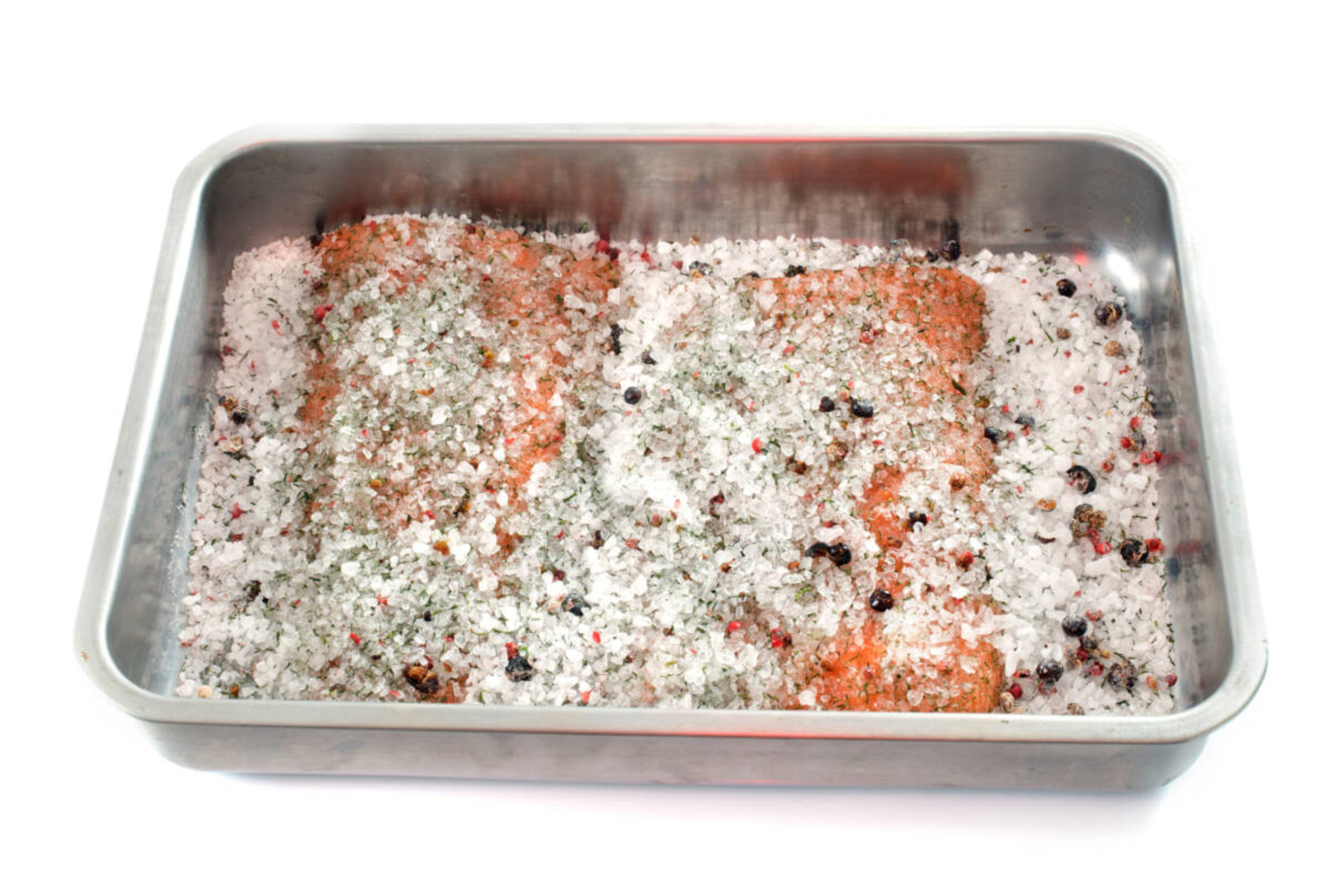Brine Salmon for a Rich, Tender, and Easy Meal
Wet or dry, this easy method will impress every time.
Nov 09, 2022
What if we told you that you just need two simple ingredients to make the juiciest, most savory salmon you've ever had? The time-tested technique can elevate any cut of fish or meat to five-star quality with barely any effort at all.
Welcome to the magic of brined fish.
Brining salmon, or any other fish, simply means preparing the fish with salt. Many recipes use herbs and spices as well, but they all share salt as a base. Brining a fillet of fish allows salto to soak into the flesh, infusing flavors deep inside while also keeping the fillet tender and juicy as it cooks. No matter the subsequent cooking method, it's a surefire way to make the fish richer and more succulent.

There are two ways to brine fish: wet and dry brining. Wet brining uses a solution of salt and water, while dry brining salmon is rubbing salt onto the fillet. In both cases, salt gets drawn inside and mixes with other ingredients while the fish cooks, imparting far deeper flavors than simply sprinkling salt on afterward.
Brining also creates a meal that's far more tender than normal, for two main reasons. First, it adds more moisture to the flesh, meaning your fillet is less likely to dry out while cooking. This can be especially helpful for relatively lean fish such as wild sockeye salmon.
The second reason for the exceptional texture of brined fish comes down to chemistry. The salt solution begins to denature, or break down, proteins, loosening tough muscle fibers and creating a far softer texture.
For salmon, brining has the added benefit of preventing unsightly albumin, the white stuff that appears while cooking, from gathering on the surface of your fillet.
How to brine salmon
To make a brine solution, use a cup of salt for every gallon of water. Note, though, that differences in grain size may require an adjustment — use a bit more if your salt is coarse, less if it is fine (more on this below).
From there, you'll lay your salmon fillets in a shallow container (a 9-inch-by-13-inch baking dish works well) and pour the solution over them, submerging them fully. Then, cover the dish with aluminum foil or plastic wrap. Refrigerate for eight to 10 hours to allow the fish to fully soak up the brine.

If you're dry brining, just rub your salt and any other ingredients on the surface of the fish and refrigerate for six to eight hours. The moisture inside the salmon will draw the salt inside the fillet.
Once your salmon is ready, you can cook it any number of ways: bake it in the oven, pan-fry it, or grill it on a cedar plank for extra flavor.
Brining is also an excellent way to prepare salmon for smoking. If you allow brined salmon to fully dry before smoking, it will develop what's called a pellicle — the thin layer of protein on the outside of the fillet that's necessary for the smoke to stick.
Making brined salmon
One of the most overlooked aspects of brining is also one of the most basic: What kind of salt you use can make a big difference in how salty your brine is and what your fish will taste like.
It boils down to the fact that salt grains come in many different shapes and sizes. Table salt, for example, is made of small grains that pack more densely together, while grains of kosher salt are much bigger. So, a cup of table salt will actually contain far more salt than a cup of kosher salt. That's why it's best to add another tablespoon or two per cup when using kosher salt for brining.
And most cooks do recommend using kosher salt for brining: It's very pure, and the larger grain sizes dissolve more easily in water. Sea salt and pink Himalayan salt, which also typically have larger grains, work well for brining too. Use lukewarm water to speed up the dissolving process.
Ingredients for brined salmon
While you can technically brine salmon with just salt and water, there's a huge variety of ingredients you can use to add flavor and nuance. Feel free to find your own favorite special blend!
Many brined salmon recipes call for brown sugar to balance the saltiness and help your salmon hold on to moisture. Other seasoning favorites include onion and garlic powder, thyme, basil, and red pepper flakes.

Lemon also goes great with salmon, but you'll need to be careful when brining: The acidity of lemon juice can toughen fish or meat, making it rubbery. For an easy way around that, just use lemon zest instead of lemon juice.
Not sure what kind of salmon to brine? We suggest starting with Wild Alaskan Sockeye Salmon for a meal that's as full of nutrients as it is flavor. If you're making a brine for smoked salmon, it's a good idea to leave the skin on to help your fillet stay together as it cooks — in that case, opt for skin-on Wild Pacific King Salmon. And if you're not sure what your favorite salmon is yet, no worries: The Wild Salmon Sampler from Vital Choice will let you test all our offerings.





.jpg?q=70&width=3840&auto=webp)


